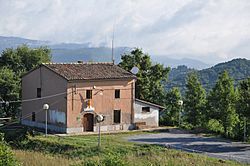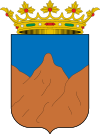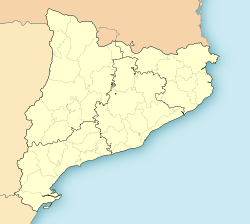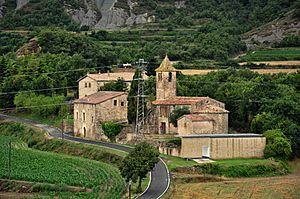Muntanyola facts for kids
Quick facts for kids
Muntanyola
|
||
|---|---|---|
|
Municipality
|
||

Muntanyola town hall
|
||
|
||
| Country | ||
| Community | ||
| Province | Barcelona | |
| Comarca | Osona | |
| Area | ||
| • Total | 40.3 km2 (15.6 sq mi) | |
| Elevation | 807 m (2,648 ft) | |
| Population
(2018)
|
||
| • Total | 620 | |
| • Density | 15.38/km2 (39.8/sq mi) | |
Muntanyola is a small municipality located in Catalonia, a region in northern Spain. It is part of the Osona area. This unique town is known for its spread-out design and beautiful natural surroundings.
Contents
Exploring Muntanyola's Unique Layout
Muntanyola is quite unusual because it doesn't have a single town center. Most of the municipality, about 75%, is covered by forested hills. These hills range from 650 to 1000 meters high. You'll find scattered farms and fields throughout this area.
Main Living Areas
The main parts where people live are in the higher areas. These include two modern housing developments. They are called Muntanyola and Fontanelles. Both of these neighborhoods have quiet streets with nice, large houses. Each house usually has a big garden.
Community Facilities
In the middle of the Muntanyola development, you can find several important places. There is a school for local children. You can also find a tennis court, a sports hall, and a swimming pool. There's even a playground and a restaurant for everyone to enjoy.
Historic Spots
The town's church and town hall are located a bit separately in the hills. They are on the northern side of the Muntanyola development. The municipality also includes an old village called Múnter. This hamlet is in the lower parts of the area, sloping down towards the Plain of Vic.
Non-Connected Areas
Muntanyola is also special because its territory is made up of four parts that don't touch each other. This means it has a main area and three smaller, separate pieces of land. Muntanyola, Fontanelles, and Múnter are all within the main area. You can reach Múnter from Muntanyola by a country path. You can also get there by going through the nearby town of Tona.
Population and Local Economy
The way Muntanyola has grown shows in its population numbers. From 1900 to 1950, about 400 to 450 people lived there. But in the 1960s, the population dropped sharply. By the early 1990s, only 171 people remained. This drop likely happened because people moved away from isolated farms.
Recent Population Growth
Starting in the 1990s, the population began to grow quickly. By 2011, it reached 568 people. At the same time, the number of homes increased by two and a half times. This growth was definitely due to the building of the new housing developments.
Main Industries
Muntanyola's economy relies on a few key activities. These include rainfed agriculture, which means farming that depends on rainfall. Forestry, or managing forests, is also important. Raising cattle for the sausage industry is another big part of the economy. In fact, there are more than 10,000 pigs in Muntanyola! Tourism is not a major source of income for the town.
A Look at Muntanyola's History
Both Muntanyola and Múnter have a very long history. The church of St. Quiricus and St. Julietta in Muntanyola was first mentioned in official papers in the year 938. The church you see today was built in the 17th century. It has simple designs from the Spanish Baroque style. Inside, you can find some beautiful Baroque paintings.
Múnter's Ancient Roots
The old village of Múnter and its church of St. Stephen were first written about in 929. Back then, it was known as villa de Montari. Both of these churches are the most important historical places to visit in the municipality. Múnter also used to have a castle. It was on a small hill near the church. Today, only a ruined part of a wall from this castle remains.
See also
 In Spanish: Montanyola para niños
In Spanish: Montanyola para niños




